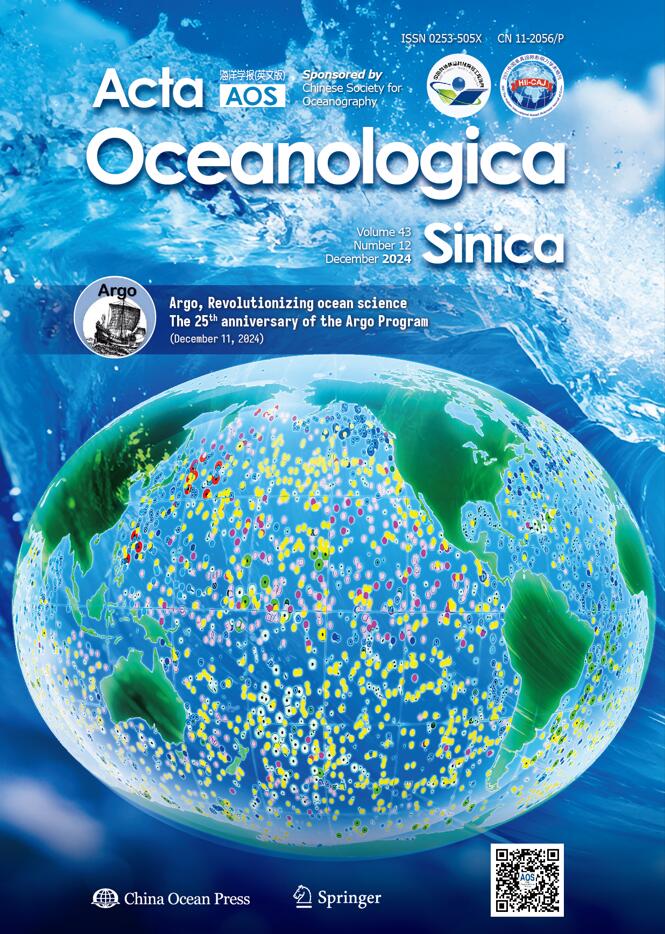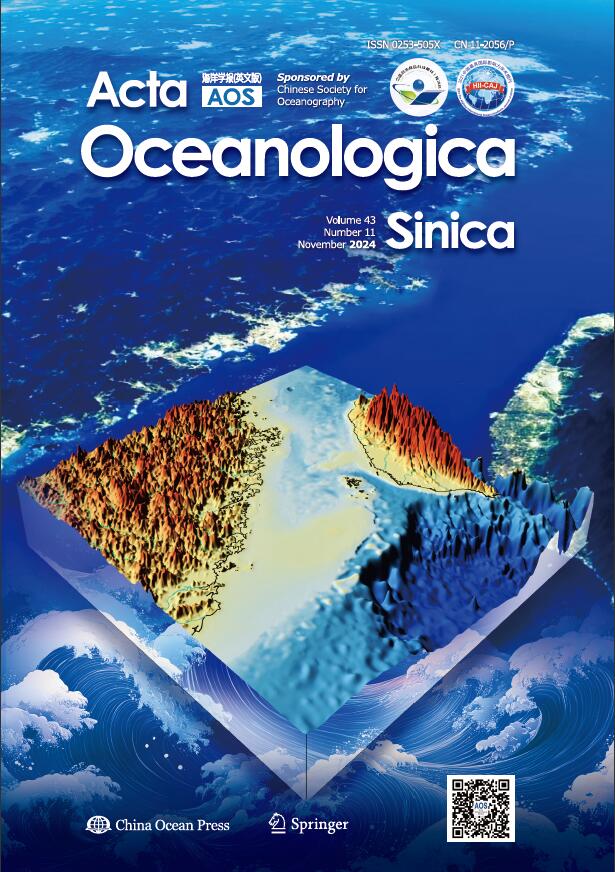2018 Vol. 37, No. 5
Display Method:
2018, 37(5): .
Abstract:
2018, 37(5): 1-7.
doi: 10.1007/s13131-018-1208-2
Abstract:
Air-sea exchange plays a vital role in the development and maintenance of tropical cyclones (TCs). Although studies have suggested the dependence of air-sea fluxes on surface waves and sea spray, how these processes modify those fluxes under TC condi...
Air-sea exchange plays a vital role in the development and maintenance of tropical cyclones (TCs). Although studies have suggested the dependence of air-sea fluxes on surface waves and sea spray, how these processes modify those fluxes under TC condi...
2018, 37(5): 8-12.
doi: 10.1007/s13131-018-1219-z
Abstract:
It is of vital importance to reduce injuries and economic losses by accurate forecasts of typhoon tracks. A huge amount of typhoon observations have been accumulated by the meteorological department, however, they are yet to be adequately utilized. I...
It is of vital importance to reduce injuries and economic losses by accurate forecasts of typhoon tracks. A huge amount of typhoon observations have been accumulated by the meteorological department, however, they are yet to be adequately utilized. I...
2018, 37(5): 13-21.
doi: 10.1007/s13131-018-1210-8
Abstract:
The sea-to-air flux of dimethylsulphide (DMS) is one of the major sources of marine biogenic aerosol, and can have an important radiative impact on climate, especially in the Arctic Ocean. Satellite-derived aerosol optical depth (AOD) is used as a pr...
The sea-to-air flux of dimethylsulphide (DMS) is one of the major sources of marine biogenic aerosol, and can have an important radiative impact on climate, especially in the Arctic Ocean. Satellite-derived aerosol optical depth (AOD) is used as a pr...
2018, 37(5): 22-28.
doi: 10.1007/s13131-018-1189-1
Abstract:
Surface sediments can integrate a wide variety of information of seawater in marginal seas, e.g., the Quaternary sedimentary shelf such as the East China Sea (ECS) and Yellow Sea (YS). The Tessier and BCR sequential extraction procedures (SEPs) have ...
Surface sediments can integrate a wide variety of information of seawater in marginal seas, e.g., the Quaternary sedimentary shelf such as the East China Sea (ECS) and Yellow Sea (YS). The Tessier and BCR sequential extraction procedures (SEPs) have ...
2018, 37(5): 29-38.
doi: 10.1007/s13131-018-1220-6
Abstract:
Kongsfjorden is a typical fjord on the edge of the ice cap of the Arctic Svalbard-Barents Sea. Its inner bay is connected with a modern glacier front along the direction of the fjord axis with a significant gradient change in the parameters of hydrol...
Kongsfjorden is a typical fjord on the edge of the ice cap of the Arctic Svalbard-Barents Sea. Its inner bay is connected with a modern glacier front along the direction of the fjord axis with a significant gradient change in the parameters of hydrol...
2018, 37(5): 39-46.
doi: 10.1007/s13131-018-1209-1
Abstract:
Seismic monitoring using ocean bottom seismometers (OBS) is an efficient method for investigating earthquakes in mid-ocean ridge far away from land. Clock synchronization among the OBSs is difficult without direct communication because electromagneti...
Seismic monitoring using ocean bottom seismometers (OBS) is an efficient method for investigating earthquakes in mid-ocean ridge far away from land. Clock synchronization among the OBSs is difficult without direct communication because electromagneti...
2018, 37(5): 47-53.
doi: 10.1007/s13131-018-1211-7
Abstract:
The study was to find out the effect of cadmium and mercury on levels of hemolymph glucose, crustacean hyperglycemic hormone (CHH) and hepatopancreas glycogen in the blue swimmer crab Portunus pelagicus. The experiments were performed in both intact ...
The study was to find out the effect of cadmium and mercury on levels of hemolymph glucose, crustacean hyperglycemic hormone (CHH) and hepatopancreas glycogen in the blue swimmer crab Portunus pelagicus. The experiments were performed in both intact ...
2018, 37(5): 54-66.
doi: 10.1007/s13131-017-1101-4
Abstract:
Sea cucumber, Apostichopus japonicus is very sensitive to light changes. It is important to study the influence of light on the molecular response of A. japonicus. In this study, RNA-seq provided a general overview of the gene expression profiles of ...
Sea cucumber, Apostichopus japonicus is very sensitive to light changes. It is important to study the influence of light on the molecular response of A. japonicus. In this study, RNA-seq provided a general overview of the gene expression profiles of ...
2018, 37(5): 67-76.
doi: 10.1007/s13131-018-1212-6
Abstract:
We examined the scale impacts on spatial hot and cold spots of CPUE for Ommastrephes bartramii in the northwest Pacific Ocean. The original fishery data were tessellated to 18 spatial scales from 5'×5' to 90'×90' with a scale interval of 5' to identi...
We examined the scale impacts on spatial hot and cold spots of CPUE for Ommastrephes bartramii in the northwest Pacific Ocean. The original fishery data were tessellated to 18 spatial scales from 5'×5' to 90'×90' with a scale interval of 5' to identi...
2018, 37(5): 77-86.
doi: 10.1007/s13131-018-1180-x
Abstract:
To understand the ecological status and macrobenthic assemblages of the Xin'an River Estuary and its adjacent waters, a survey was conducted for environmental variables and macrobenthic assemblage structure in September 2012 (Yantai, China). Several ...
To understand the ecological status and macrobenthic assemblages of the Xin'an River Estuary and its adjacent waters, a survey was conducted for environmental variables and macrobenthic assemblage structure in September 2012 (Yantai, China). Several ...
2018, 37(5): 87-95.
doi: 10.1007/s13131-018-1166-8
Abstract:
Shelf-basin advection is essential to subsistence of the Arctic copepod Calanus hyperboreus population in high basin area. Its abundance, population structure and body size in pelagic layer were investigated with samples collected over a large range ...
Shelf-basin advection is essential to subsistence of the Arctic copepod Calanus hyperboreus population in high basin area. Its abundance, population structure and body size in pelagic layer were investigated with samples collected over a large range ...
2018, 37(5): 96-106.
doi: 10.1007/s13131-018-1149-9
Abstract:
Picoplankton distribution around the Zhangzi Island (northern Yellow Sea) was investigated by monthly observation from July 2009 to June 2010. Three picoplankton populations were discriminated by flow cytometry, namely Synechococcus, picoeukaryotes a...
Picoplankton distribution around the Zhangzi Island (northern Yellow Sea) was investigated by monthly observation from July 2009 to June 2010. Three picoplankton populations were discriminated by flow cytometry, namely Synechococcus, picoeukaryotes a...
2018, 37(5): 107-112.
doi: 10.1007/s13131-018-1167-7
Abstract:
Microalgae are photosynthetic microorganisms that function as primary producers in aquatic ecosystems. Some species of microalgae undergo rapid growth and cause harmful blooms in marine ecosystems. Heterocapsa triquetra is one of the most common bloo...
Microalgae are photosynthetic microorganisms that function as primary producers in aquatic ecosystems. Some species of microalgae undergo rapid growth and cause harmful blooms in marine ecosystems. Heterocapsa triquetra is one of the most common bloo...
2018, 37(5): 113-116.
doi: 10.1007/s13131-018-1175-7
Abstract:
A 105-kDa polymer lectin was purified from lamprey (Lampetra japonica) serum by chromatography methods including cation ion-exchange chromatography with a SP-SepharoseTM XL column and size exclusion chromatography with a Superdex 200 column. The targ...
A 105-kDa polymer lectin was purified from lamprey (Lampetra japonica) serum by chromatography methods including cation ion-exchange chromatography with a SP-SepharoseTM XL column and size exclusion chromatography with a Superdex 200 column. The targ...














